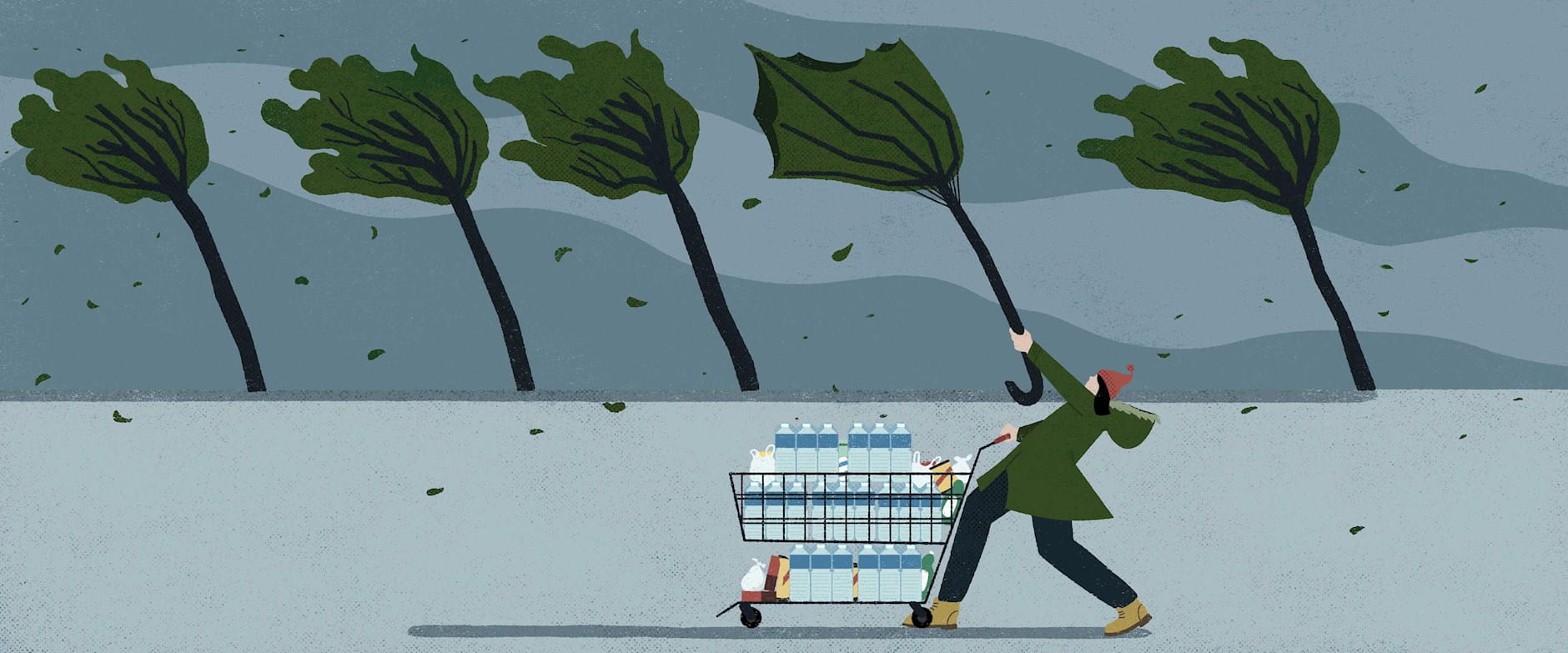Ice storms in Minnesota aren’t anything new. Neither are hurricanes in Florida. But extreme weather events are increasingly hitting regions where people are less used to them—and less prepared. Hurricane Ida, for example, caused destruction and flooding across the northeastern United States in 2021.
How do people who aren’t used to disasters prepare when one is imminent? In a study of New Jersey consumers affected by Hurricane Sandy, Penn State PhD candidate Daniel P. Simandjuntak and Penn State’s Edward C. Jaenicke and Douglas H. Wrenn find that they started by stockpiling necessities at large retailers, then worked their way to smaller outlets. Knowing this could help the government and other agencies manage relief efforts and keep supply chains running during disasters, the findings suggest.
Researchers are increasingly studying how natural disasters affect consumer behavior. One project, by University of California at Davis’s Timothy K. M. Beatty, University of Virginia’s Jay P. Shimshack, and Cal Poly’s Richard J. Volpe analyzed sales of emergency supplies in US locations affected by hurricanes between 2002 and 2012. Stores in southeastern and Gulf coast states generally experienced more emergency item purchases prior to storms, but only immediately before landfall, while emergency purchases after storms were very large. Moreover, stores in zip codes and counties with lower-income, less-educated, and larger Black populations experienced smaller increases in sales of emergency goods as hurricanes approached and larger increases in sales of emergency-response goods after hurricanes made landfall. “Our results suggest that households do not follow government advice to adequately stock emergency supply kits when hurricanes first threaten and to stay off roads after hurricanes make landfall,” the researchers write, adding that “potentially vulnerable groups may be less prepared for disasters, suffer greater damages from disasters, or both.”
Would residents of areas less familiar with such weather events be caught similarly unprepared? To find out, Simandjuntak, Jaenicke, and Wrenn, with funding from Open Philanthropy, analyzed household grocery purchases before and after Hurricane Sandy, which made landfall in New Jersey in 2012. The state had previously been mostly unaffected by hurricane seasons, but Sandy became the fourth costliest tropical cyclone in US history, causing almost $80 billion in damage.
Simandjuntak, Jaenicke, and Wrenn examined purchases of five items: bottled water, peanut butter, canned beans, dried pasta, and toilet paper. They looked at where those purchases were made and how they were borne differently by small, medium, and large supermarkets and other retailers. Using NielsenIQ Retail Scanner and Homescan Data housed at Chicago Booth’s Kilts Center for Marketing, the researchers analyzed weekly sales at stores in terms of both volume and individual products.
Their analysis compared sales made inside a 100-mile radius of Hurricane Sandy’s path with those made elsewhere, and controlled for seasonality by analyzing sales data from the prior year. They categorized grocery stores according to how much bottled water they sold over the same period in 2011: small grocers sold less than 3 million ounces; medium grocers, less than 9 million ounces; and large grocers, 9 million ounces or more.
A week before the storm, purchases increased for all five items at grocery stores of all sizes, drug stores, and mass merchandisers, with most shoppers stockpiling from the largest big-box stores.
Peanut-butter sales were 40 percent higher at large food grocers than the same week a year earlier. As the hurricane approached, consumers turned to medium and small grocers, where average peanut-butter purchases rose 51 percent and 71 percent, respectively, from a year before.
“Consumers tend to go to the biggest supermarkets first and then move on down the line,” Jaenicke says.
Bottled-water purchases followed a similar pattern. A week before Sandy, large grocers saw a 61 percent year-over-year increase in bottled water sold. The week of the hurricane, average purchases were up 65 percent for medium food grocers and 104 percent for small food grocers.
Purchases didn’t differ much across demographics, though a week before the hurricane, households with an annual income of $50,000 and above stockpiled about 13 more ounces of bottled water per member than others did. The research also finds that consumers bought more private-label products over brand-name ones, although it’s unclear if people preferred the less-expensive private labels or bought those because the brand-name alternatives were sold out.
As the timing of natural disasters becomes more frequent and the locations more unpredictable due to climate change, Simandjuntak, Jaenicke, and Wrenn’s findings on panic-buying behavior could help ensure stores do not run out of critical supplies as disasters loom.
- Daniel P. Simandjuntak, Edward C. Jaenicke, and Douglas H. Wrenn, “Heterogeneity in Consumer Food Stockpiling and Retailer Experiences during Hurricane Sandy,” Working paper, in progress.
- Timothy K. M. Beatty, Jay P. Shimshack, and Richard J. Volpe, “Disaster Preparedness and Disaster Response: Evidence from Sales of Emergency Supplies before and after Hurricanes,” Journal of the Association of Environmental and Resource Economists, July 2019.
Your Privacy
We want to demonstrate our commitment to your privacy. Please review Chicago Booth's privacy notice, which provides information explaining how and why we collect particular information when you visit our website.
